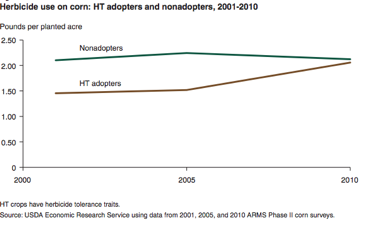One of the most popular arguments for GE crops is that they reduce the amount of pesticides farmers have to use. The graph below shows the use of weed killer by conventional farmers (top line) and GE farmers (bottom line). “HT” stands for “herbicide tolerant,” e.g., corn that withstands weed killer). The use of weed killer on conventional corn crops is going down; the use on GE crops is going up.

Farmers are using increasing amounts of weed killer because of glyphosate (Roundup). It has to be applied more often in higher amounts.
In addition, the increased use of Roundup has spawned superweeds—abnormally large weeds resistant to glyphosate. Now farmers are using more toxic weed killers in addition to Roundup. This escalating war is predicted to dramatically increase weed killer use in the future—an indication that this GE weed control, at least, is not sustainable.
Insecticide use is decreasing in crops that are genetically modified with the Bt (Bacillus thuringiensis) gene. Bt-modified crops are believed to be nontoxic, so this is good news—but is it sustainable?
Bt is a soil bacterium which synthesizes a toxin that kills certain insects, particularly caterpillars. It was sold as a natural pesticide for decades before it was “GE’d” into food crops.
Within eight years of American farmers planting a million hectares of GE Bt crops, resistance was reported. Farmers are required to plant non-GE plants around their fields of GE plants as so-called “refuge” crops. Refuge crops are supposed to stop or delay insects and weeds from developing resistance. It’s apparently not working. The solution, according to GE manufacturers, is more genes, more mutations, more GE.